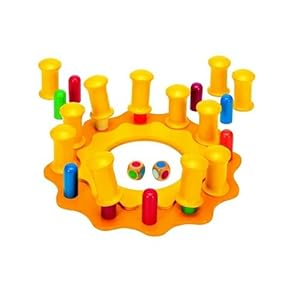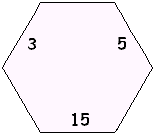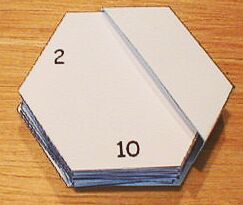I am my father's daughter.
But I did not inherit this gene. If I haven't worn it or used it in six months, it's tossed in the perpetual and permanent thrift store box in the garage. Sentimental value is relative around here, and oft times, I'm guilty of tossing things I shouldn't. That's my gift to the thrift-store world. You're welcome.
One thing I haven't completely tossed, and perhaps I should, is a hat I used to wear - one that I thought I might dust off today, one I might have inherited from my father. It's the "Math Teacher" hat. I'm not going to be designing any bridges in the near future, but I can calculate a tip faster than I can type it all into my cell phone. (Admittedly, this is not evidence of math genius, just an admission of my own cell-phone illiteracy.) And for the record, the hat is metaphorical, I never had a hat. Or a nameplate, or a locker, or a Teacher of the Year award. But I loved teaching high school math. Although I don't venture there much any more, I still love math, maybe even more now that I'm doing it at the kitchen table with a seven-year old.
So, this is where I get all crazy-practical on you. I am officially blowing off the dust and planting the "Math Geek" hat firmly on my head. If that isn't bad enough, I'm putting on a prairie bonnet over the top that says "Homeschooling Mother." Scary, I know. But with both firmly in place, I would like to humbly offer my once-a-year educational diatribe:
- Perhaps the biggest mistake that I see educators make in their approach to math is this: introducing math concepts prematurely. For instance, it is my own personal belief that children are not even mentally prepared to analyze fractions until fifth or sixth grade, perhaps even later. When we introduce ideas like adding fractions to eight-year olds, they get the deer-in-the-headlights look and completely deflate. By the time they hear the word "fraction" in high school, they break out in hives! Why do we do that to them?! Is it kind, gentle, or in all practicality, effective? Of course not! If you have a math genius on your hands, this probably doesn't apply to you. If you have an average math student on your hands, I would encourage you here: you do your child no favors by pressing them to higher math concepts until 1) they are mentally ready; and 2) the concepts are necessary for other learning to take place.
- If demanding mastery of math concepts prematurely is the biggest mistake I see early educators make in teaching mathematics, the biggest area of neglected mastery are the basic math facts. I know that this is not unique nor is it popular; in fact, telling math students to learn their math facts is like the doctor telling us to eat better, exercise more. But take it from a high school math teacher who watched students - AP students no less! - panic when asked basic math facts, it is essential to success in math. A rigorous few weeks or months in the elementary years will produce years of natural success in other areas of math. I promise to tell you about my own way of teaching the math facts down below, (see nuts and bolts).
- For the preschool years, I think there are two math essentials for kids: basic counting and practical number sense. The first is self-explanatory. Our kids love dot-to-dots, and a few age-appropriate ones had them counting to twenty before we knew it. The second math essential is a natural approach to numbers as they come up in life - in conversation, in the grocery store, in unloading the piggy bank, in measuring inches on the wall. Preschool Express is full of great math ideas to check out.
- For all ages, games can be a great way to make math fun. Around here, we play the old card game of War with our children, wherein two people flip cards over and whomever has the larger number wins both cards. Another great game is Pass the Pig. Have you played this with your preschooler??? It's addicting! And it teaches tallying and skip-counting by fives (not necessary for preschoolers, but an added bonus, nonetheless).
 One other game our family loves is Maask, a wonderful wooden game that teachers matching and sorting. Our four-year old loves this game, and so does her mother.
One other game our family loves is Maask, a wonderful wooden game that teachers matching and sorting. Our four-year old loves this game, and so does her mother.
 The nuts and bolts: we have used workbooks, flashcards, and even a textbook to teach math. I have a math video and we have made rhymes. While there are many peripheral math concepts at the elementary age, the basic addition and multiplication math facts are the most important learning element. Here are my all-time favorite tricks for teaching them:
The nuts and bolts: we have used workbooks, flashcards, and even a textbook to teach math. I have a math video and we have made rhymes. While there are many peripheral math concepts at the elementary age, the basic addition and multiplication math facts are the most important learning element. Here are my all-time favorite tricks for teaching them:- Students need to learn multiplication families, not just the facts. What I mean by this is that somehow, we need to teach kids that not only does 3 x 9 = 27 and 9 x 3 = 27, but if you are given a 9 and a 27, the missing family member is a 3; or if you are given a 3 and a 27, the missing family member is 9. If our students can get this, they have really grasped multiplication AND division. No need to learn the facts twice. What we use in our house is a flash card like this:


I found all the printables for these flash cards here: www.mathcats.com.
We only do a few of these each day, and we go over them for about ten minutes or so, until Punkin really knows those numbers. Then, periodically throughout the day, I'll tease her with a question. Today's math fact was 6 x 7 = 42. I asked her this question probably ten times today, sometimes reversing the order by asking, "What's seven times six?"
The great news - this system really seems to be working!
2. Math-It and Pre-Math-It: this is an older not-quite-a-curriculum that my husband did as a kid. He's a math whiz (who beats me at calculating the tip), so it must have worked for him. The students start by playing with dominoes to learn adding numbers from 1 to 20. Once this is done, they start playing some games. The first game is called Addit, and it teaches, well, addition. Once the child can lay all of the math fact cards down on the laminated board within an appropriate time limit, you move on to the second game, Dubblit, which I think is a mathematician's spelling of the words "Double It." This one is my favorite! By the time the student has mastered the game, they know most important doubles up through 100 (e.g., double 8 is 16, double 36 is 72...). AND they flip the board over and reverse the facts so that they know most of the important halves up through 100 (e.g. half of 64 is 32, half of 24 is 12.). Lastly, they move to TimzIt - which we must forgive the author for not knowing how to spell. To be honest, this is my least favorite of the games - children memorize the location of the answers (because they are color-coded) and can get away with not really knowing the answers. All in all, though, this has been a great system, mostly student-directed, funner than worksheets, and I believe, less time-consuming too. The learning is intense and rigorous, but given in small chunks. Things I don't like about this system are twofold: first, it is not a curriculum; just a learning tool. And secondly, the manual is tricky with odd (but good!) ways to carry and borrow numbers. This can be tricky, even for some one who is fairly comfortable with math.
Whew! What a mouthful of me trying to be smart! I hope that it helps some of you who are educators, either at a school or at home.
What math tricks do you love? Games? Websites? Tutorials?
My practical side says, "Knock it off and go to bed." So, I will.
Wishing you all many battle-free math moments this week.
Resting in His Beyond-Mathematics Grip,
Karen
2 comments:
Thanks, Karen! Those are really helpful tips and games. We use Math-U-See with Ethan. It uses blocks as visual aids to teach math and it has been really helpful for Ethan.
Their website has a free video demonstration that does a good job teaching place value. https://www.mathusee.com/
A nice freebie without having to buy the whole curriculum.
I just love your math geek side! Thanks for the math reviews and ideas. I do agree that the only way a younger can be successfully introduced to fractions is if you have pie, lots of pie. K
Post a Comment